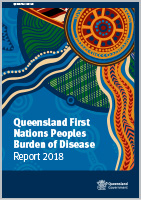Burden of Disease
What is a burden of disease study?
Burden of disease studies provide a comprehensive assessment of the impact of disease and injury on a population. These studies use a summary measure of population health, the Disability-Adjusted Life Year (DALY), to estimate health loss through both morbidity and mortality. Data from multiple sources are combined to cover all health loss from a comprehensive list of causes.
Why do a burden of disease study?
Burden of disease and injury estimates provide evidence for informed decision making and policy development. They identify areas and conditions which cause the greatest loss of healthy life, allowing for targeted intervention and needs based resource allocation. The consistent and comprehensive nature of burden of disease studies are also useful for comparing the relative health loss of different population groups, informing efforts to increase health equity.
Queensland First Nations Peoples Burden of Disease Report 2018
This report is based on the third burden of disease study undertaken by Queensland Health that measures the health loss of First Nations peoples.
While the Queensland Burden of Disease Study 2018 produced estimates for the entire Queensland population, this report focusses on the results for First Nations peoples of Queensland.
The report shows trends in the burden of disease experience from 2011 to 2018 and highlights the substantial work ahead to address the health needs of the Queensland First Nations peoples.
There have been significant reductions in cardiovascular disease burden. However, mental health and substance use disorders are a standout regarding the amount of health loss caused, and the rate of increase in health loss.
Significant differentials in rates and cause of burden across geographic regions, and between First Nations peoples and other Queenslanders, are further evidence of the considerable work that needs to be done to address health inequity in Queensland.
Other key findings
Overall, there was a 4% reduction in the burden of disease and injury rate for First Nations peoples in Queensland from 2011 to 2018 after accounting for changes to population size and age.
There was no change in the relative rate of burden between First Nations peoples and other Queenslanders between 2011 and 2018, with the ratio for both periods being unchanged at 2.1 times the rate of disease burden for First Nations peoples in Queensland.
Mental and substance use disorders were the leading cause group for First Nations people in 2018, with nearly one in four DALYs due to this group of conditions (24%).
Injury was the second largest cause of disease burden, responsible for 12% of First Nations DALYs in 2018.
Cancer and other neoplasms surpassed cardiovascular disease to become the third leading cause of disease burden in 2018 for First Nations peoples in Queensland at 10% of disease burden. This swap in the ranking was due to the large decrease in the rate of cardiovascular disease burden.
Previous reports
Due to improving methodologies and information, burden of disease reports are not directly comparable. Differences should not be interpreted as change in health status over time. Please refer to the most recent report for change over time.
- The burden of disease and injury in Queensland’s Aboriginal and Torres Strait Islander people 2017 (reference year 2011) summary report (PDF 1406 kB)
- The burden of disease and injury in Queensland’s Aboriginal and Torres Strait Islander people 2017 (2011 reference year) main report (PDF 2471 kB)
- The burden of disease and injury in Queensland’s Aboriginal and Torres Strait Islander people 2017 (2011 reference year) Hospital and Health Service profiles (PDF 1782 kB)
- Burden of disease and injury for Aboriginal and Torres Strait Islander people 2014 (PDF 2126 kB)
Contact
For more information, please email the Performance and Reporting Team, First Nations Health Office at FNHO_PERFORMANCE_REPORTING@health.qld.gov.au.
